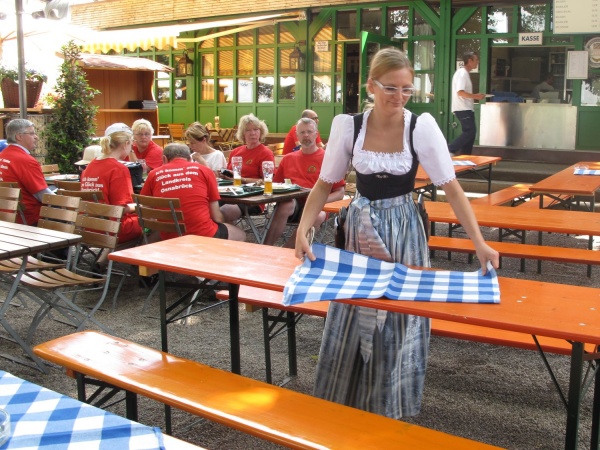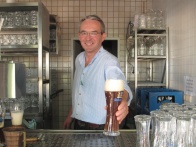Difference between revisions of "Bräustüberl Weihenstephan"
| Line 1: | Line 1: | ||
| − | Bräustüberl Weihenstephan and beer garden is located on a hilltop next to the Weihenstephan Brewery | + | '''Bräustüberl Weihenstephan and beer garden is located on a hilltop next to the Weihenstephan Brewery |
| − | in Freising, 43km north of Munich. The beer garden offers views of the sourrunding area. | + | in Freising, 43km north of Munich. The beer garden offers views of the sourrunding area.''' |
| + | |||
| + | <table cellpadding="0" cellspacing="0" border="0" style="padding-bottom:6px;"><tr> | ||
| + | <td colspan="3" style="padding-bottom:6px;">[[File:Braeustueberl Weihenstephan 001.jpg|600px]]</td></tr> | ||
| + | <tr><td align="left">[[File:Braeustueberl Weihenstephan 003.jpg|196px|none]]</td> | ||
| + | <td align="center">[[File:Braeustueberl Weihenstephan 008.jpg|196px|none]]</td> | ||
| + | <td align="right">[[File:Braeustueberl Weihenstephan 004.jpg|196px|none]]</td></tr></table> | ||
| + | |||
Weihenstephan is the oldest brewery in the world. In year 725 the Benediktiner Monestary was founded on the hilltop. The monks invented the brewing of beer and in 1040 the Klosterbrauerei Weihenstephan was officially opened. During the next 1000 years the monastery went throught difficult times. Weihenstephan was ran over and destroyed many times by the Swedes, French and Austrians. Besides that, the monestary brurnt down completely four times. A heavy earthquake in 1348 and three plague epedemics did not make the monks give up. Unfortunately, in 1803 the monestery was closed and all the interiors and rights went into the hands of the state of Bavaria. However, the brewery was under the rule of the Royal Staatsgut Schleißheim (Munich) and could therefore continue. In 1852 the Bavarian Brewery School moved from Schleißheim to Weihenstephan where the art of brewing is still tought. The location is today the centre of the brewing technology in Germany and worlwide. | Weihenstephan is the oldest brewery in the world. In year 725 the Benediktiner Monestary was founded on the hilltop. The monks invented the brewing of beer and in 1040 the Klosterbrauerei Weihenstephan was officially opened. During the next 1000 years the monastery went throught difficult times. Weihenstephan was ran over and destroyed many times by the Swedes, French and Austrians. Besides that, the monestary brurnt down completely four times. A heavy earthquake in 1348 and three plague epedemics did not make the monks give up. Unfortunately, in 1803 the monestery was closed and all the interiors and rights went into the hands of the state of Bavaria. However, the brewery was under the rule of the Royal Staatsgut Schleißheim (Munich) and could therefore continue. In 1852 the Bavarian Brewery School moved from Schleißheim to Weihenstephan where the art of brewing is still tought. The location is today the centre of the brewing technology in Germany and worlwide. | ||
| Line 9: | Line 16: | ||
Bräustüberl Weihenstephan offers ??13?? types of beer. A Maß Helles costs €5.80. | Bräustüberl Weihenstephan offers ??13?? types of beer. A Maß Helles costs €5.80. | ||
| − | |||
| − | |||
| − | |||
| − | |||
| − | |||
| − | |||
<googlemap version="0.9" lat="48.395552" lon="11.728656" zoom="14" controls="large"> | <googlemap version="0.9" lat="48.395552" lon="11.728656" zoom="14" controls="large"> | ||
Revision as of 16:29, 12 July 2010
Bräustüberl Weihenstephan and beer garden is located on a hilltop next to the Weihenstephan Brewery in Freising, 43km north of Munich. The beer garden offers views of the sourrunding area.
 | ||
Weihenstephan is the oldest brewery in the world. In year 725 the Benediktiner Monestary was founded on the hilltop. The monks invented the brewing of beer and in 1040 the Klosterbrauerei Weihenstephan was officially opened. During the next 1000 years the monastery went throught difficult times. Weihenstephan was ran over and destroyed many times by the Swedes, French and Austrians. Besides that, the monestary brurnt down completely four times. A heavy earthquake in 1348 and three plague epedemics did not make the monks give up. Unfortunately, in 1803 the monestery was closed and all the interiors and rights went into the hands of the state of Bavaria. However, the brewery was under the rule of the Royal Staatsgut Schleißheim (Munich) and could therefore continue. In 1852 the Bavarian Brewery School moved from Schleißheim to Weihenstephan where the art of brewing is still tought. The location is today the centre of the brewing technology in Germany and worlwide.
The beer garden has 360 seats in the self service area, 10 seats on the serviced terrace and 80 seats in the beer garden Salett'l (outside roofed seating area). Large ??Linde?? trees completely shade the self-serviced area while the serviced tables have sun-umbrellas.
Apart from beeing the oldest brewery in the world, Weihenstephan is also the birthplace of the "Obazda", a Bavarian cheese specialty. Katharina Eisenreich, the Innkeeper of the beer garden between 1920 until 1958, began serving homemade Obazda to the guests, which soon thereafter became a traditional Bavarian dish that is sold in every beer garden today (reciepe). Industrial production of Obazda, including export products, is still only done in Bavarian
Bräustüberl Weihenstephan offers ??13?? types of beer. A Maß Helles costs €5.80.
Bräustüberl Weihenstephan is open from 10am until midnight everyday.
Bräustüberl Weihenstephan
Weihenstephaner Berg 10
85354 Freising (Weihenstephan)
Germany
Tel: +49-(0)8161-13004
Website: www.braeustueberl-weihenstephan.de


